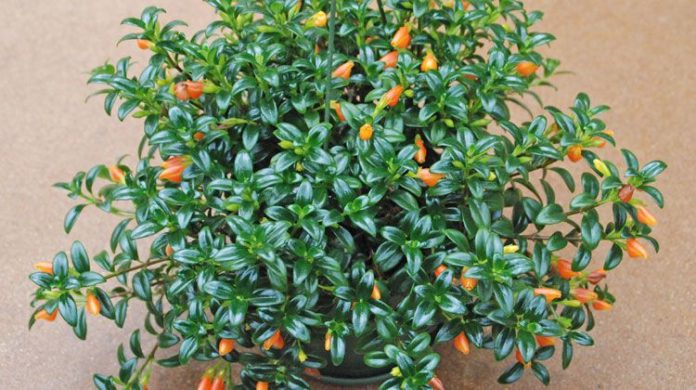Goldfish Plants type: perennial
Sun Exposure: Bright light
Bloom Time: Spring, summer, fall, winter
Flower color: Red, Orange, Yellow
Mature size: stems 2 to 3 in. long, branches up to 3 ft. long
Soil Type: Well-drained
Hardiness zones: 10 to 11 (USDA)
Native areas: Central America, Caribbean
The botanical name of the goldfish plant is “Columnea Gloriosa and hybrids”.
The name of the goldfish plant originated from the name of a long, tubular orange-red flower that looks like Goldfish. It is a hanging indoor plant. It works best at room temperature of 65 to 75 degrees Fahrenheit. However, these plants require high humidity. Goldfish plants are highly rewarding. Sometimes the plant itself grows to 3 ft., You may also cut down its stems and makes it 2 inches tall only.
Read More- Do Deer Eat Hydrangeas?
Goldfish plant care:
These plants are very sensitive to high temperatures and the moisture of their leaves. So, if you notice brown leaves on plants, cut them off and make sure that you keep the plant away from sun exposure.
Another thing that can affect this plant is poor daily care routine. Some common signs of problems are leaf drop, leggy growth, and lack of flowering. As this plant needs a high level of humidity, you need to be extra cautious about watering it as it can also damage the plant. You should do a careful inspection of the plants every day. Also, it is important to remember that these plants are prone to mold and fungus growth.
Read More- What Are Some Good Creepers Plants Example?
Few factors affecting goldfish plants
Light:
Goldfish plants need bright light. However direct sunlight is harmful to them. An eastern-facing window is perfect for these plants. These plants can also grow under indoor lights, especially during the winters.
Soil:
Well-drained soil is perfect for growing goldfish plants. In the wild, the goldfish plants are epiphytes that grow upon other plants. Usually, it grows on trees.
Water:
At the time of summer, water generously keeps the soil moist. At the time of winter, water helps the plants to create humidity itself. The main thing to remember is that the soil should not be dried as it can affect the growth of the plant.
Temperature:
Many people believe that tropical plants need high humidity and heat to thrive. However, most tropical plants grow under the canopy of other plants. Goldfish plants grow best at room temperature of 65 to 75 degrees Fahrenheit. Also, these plants need high humidity and warm water. Coldwater can damage the foliage.
Fertilizers:
Feeding plants weekly during the growing stage is very important. It is recommended to use liquid fertilizers as it includes micronutrients and increases the blooming. Another good option is Controlled release fertilizer pellets.
Read More- 31 Best Plants For Rock Garden
Varieties of Goldfish plants:
For now, there are at least 25 different varieties of goldfish plants available in the market and some of them have the same fuzzy leaves. The varieties have red or yellow flowers, and the “firelight” variety has lovely variegated leaves.
Propagation of Goldfish plant:
Propagating a goldfish plant is relatively easy. For this, you just need a two to three-inch-long stem tip that does not have any flower buds. Remember to leave two or three leaves on plants to undergo photosynthesis and grow. If you are tentative about snipping the foliage, remember that cutting back a goldfish plant will eventually help it to grow back fuller.
Read More- Learn More about Calcium Deficiency in Plants
How to remove pests from Goldfish plants?
The goldfish plant hosts pets such as mealybugs, thrips, and spider mites. However, sometimes these critters go unnoticed because of the clusters of leaves of the goldfish plant. Make sure to take care of them from time to time and mainly check the underside. If you see any creepy crawlers, give a good water spray to your plant and remove the bug. After this apply neem oil, a natural pesticide, to the leaves to prevent future infestations also after 2-3 months you are required to change the soil of the plant.
Read More- How Do You Care For a Peperomia Ruby Cascade?
Problems of keeping goldfish house plants:
Following are some of the disadvantages of keeping goldfish houseplant:
- Leggy growth of the plant
- Leaf drop
- Lack of flowering
- Too much space required
- Fungus prone leaves
- Requires high care.
Read More- How To Hang Pothos Plant?
The Bottom line:
The goldfish plant is one of the most beautiful indoor plants. It doesn’t need high sunlight; it can grow in indoor lights also. However, it needs good care and a high level of humidity to grow fuller.
So, if you’re planning to buy goldfish make sure to read the above article carefully.
Read More- Popular Dracaena Plant Types To Keep In Your Indoor Garden

















